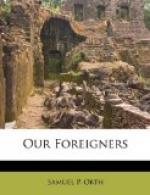A like transformation has taken place in the manufacturing towns of New York, New Jersey, and Delaware and in the iron and steel towns of Pennsylvania, West Virginia, and the Middle West. For forty years after the establishment of the first iron furnace in Johnstown, Pennsylvania, in 1842, the mills were manned exclusively by Americans, English, Welsh, Irish, and Germans. In 1880 Slavic names began to appear on the pay rolls. Soon thereafter Italians and Syrians were brought into the town, and today sixty per cent of the population is of foreign birth, largely from southeastern Europe. The native Americans and Welsh live in two wards, and clustered around them are settlements of Italians, Slovaks, and Croatians.
The new manufacturing towns which are dependent upon some single industry are almost wholly composed of recent immigrants. Gary, Indiana, built by the United States Steel Corporation, and Whiting, Indiana, established by the Standard Oil Company for its refining industry, are examples of new American towns of exotic populations. At a glass factory built in 1890 in the village of Charleroi, Pennsylvania, over ten thousand Belgians, French, Slavs, and Italians now labor. An example of lightning-like displacement of population is afforded by the steel and iron center at Granite City and Madison, Illinois. The two towns are practically one industrial community, although they have separate municipal organizations. A steel mill was erected in 1892 upon the open prairies, and in it American, Welsh, Irish, English, German, and Polish workmen were employed. In 1900 Slovaks were brought in, and two years later there came large numbers of Magyars, followed by Croatians. In 1905 Bulgarians began to arrive, and within two years over eight thousand had assembled. Armenians, Servians, Greeks, Magyars, every ethnic faction found in the racial welter of southeastern Europe, is represented among the twenty thousand inhabitants that dwell in this new industrial town. In “Hungary Hollow” these race fragments isolate themselves, effectively insulated against the currents of American influence.
The mining communities reveal this relative displacement of races in its most disheartening form. As early as 1820 coal was taken from the anthracite veins of northeastern Pennsylvania, but until 1880 the industry was dominated by Americans and north Europeans. In 1870 out of 108,000 foreign born in this region, 105,000 or over ninety-seven per cent came from England, Wales, Scotland, Ireland, and Germany. In 1880 a change began and continued until in 1910 less than one-third of the 267,000 foreign born were of northern European extraction. In 1870 there were only 306 Slavs and Italians in the entire region; in 1890 there were 43,000; in 1909 there were 89,000; and in 1910 the number increased to 178,000.




